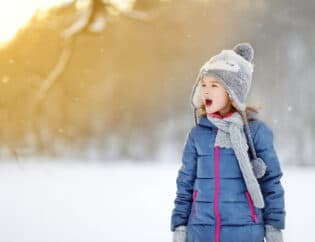
A walk in nature can provide the perfect dose of rich sensory information that can help restore your child’s mind and help develop their body with the many sounds, smells, textures, temperatures, and colors it offers. But often, when we’re outside, we rely too heavily on our eyes and lower the volume on the other senses— like sound.
Yet when we tune in, we hear sounds all around us— a cacophony or orchestra of the sounds of nature, revealing the life that is all around is, some hidden and some distant.
This quick, 15-minute “sound of nature” activity will help your child discover a whole new world, be more mindful and more tuned in to nature.
To encourage sound sensory exploration, find a spot outdoors with little human-made noise such as from traffic, construction or, heaven forbid, leaf blowers. You can find a quiet spot when you are outside on a hike or simply take a break outside in your backyard or in a nearby park. To hear more sounds, heading out at dawn and dusk are the most active times for birds or amphibians, but likely not ideal for children unless you go right outside to your backyard. Also, don't underestimate rainy days. Birds and frogs love to chatter after it rains. Turns out they have so much to say after the silence of a rainstorm.
To begin, let your child know that they are about to discover the unseen world of nature and will need to rely on their super sense of hearing to do so. Ask them to try to keep their body still and calm and grow their ears like a bat or a giraffe, funneling in all sounds they hear.

They should quiet their inside noises and tune out noises from themselves and other people. This sounds easier than it is. Kids are not accustomed to sitting still, never mind not talking. Adults too, for that matter. But quieting the body and the mind will open up a hidden world that our senses desperately need.
Now tell them to close their eyes and take in as many sounds as they can. In the springtime, there are so many sounds due to birds and amphibians but other seasons have their own soundtrack. A windy day provides us with the sound of rustling treetops or the creaking sound of a swaying tall tree. In the summer, streams can be heard gurgling. In the winter, ice cracking or snow crunching.

Once they tune in to a few sounds, have them focus on one or two sounds. Ask them to repeat it themselves. Then ask them to describe the patterns of the sounds. Is it a repeat pattern? Does it stop and start or is it steady and constant?
Now ask them how far away they think the sound is? Can they hear a difference in nearby and far away sounds?
At this point, they might want to know who or what is making the sound or they may just be content with having focused in on a sound and calmed their mind. Remember, identifying the sound may help your child learn about the natural world, but it is not more educational than the practice of just tuning in and hearing it. It may be fine to stop here or you may want to explore further. If so, ask your child to take their best guess at who or what is making the sound. Could it be a gurgling brook? A noisy chipmunk? The screech of a hawk overhead? Ask them to use clues about where the sound is coming from an what they know about animal habitats to make an educated guess.
To aid with ID, equip your iphone with an app or two to identify sounds. For bird songs, check out SongSleuth. A great thing about SongSleuth it starts capturing sound as soon as you boot it up, displaying it on a spectrogram. Once you’ve identified your bird and made notes, Song Sleuth saves it to a map of all your recordings. If SongSleuth has too many bells and whistles, try a simpler app like ChirpOMatic which links to each bird’s entry in the Cornell Lab of Ornithology and Wikipedia. For other sounds, find an app that works best for you. There are quite a few available including Cicada Hunt for identifying insects.
Once you have talked about who is making the sound, ask your child what the sounds look like to them? You can ask them to take out their drawing pad and sketch out the shape, the pattern of the sound. What colors would they be? They can also create artwork at home. Another idea for older children is to capture the sound is to record it on your phone and then have them create a musical piece.
Later, at home or on your walk, ask your child how it felt to listen to the sounds of nature and if they experienced nature differently by tuning in with their ears. Was one sound in particular that stayed with them?











